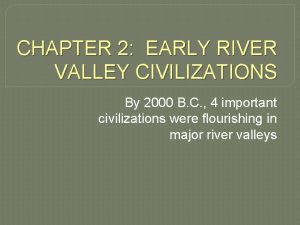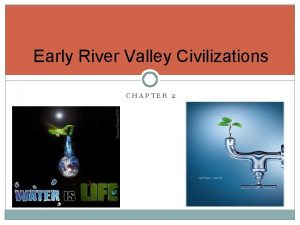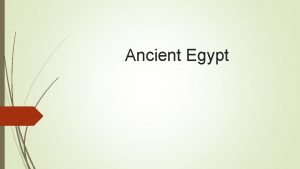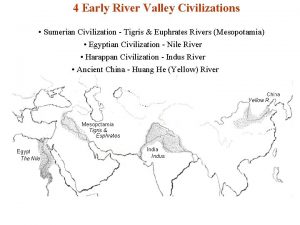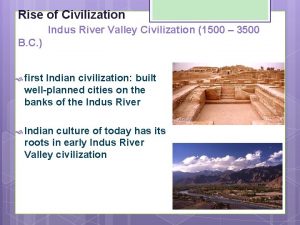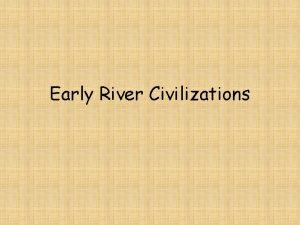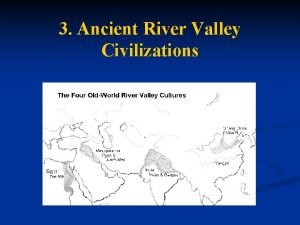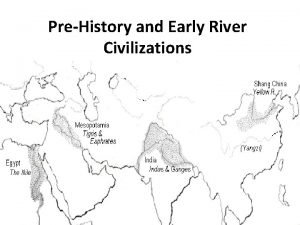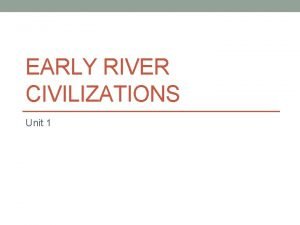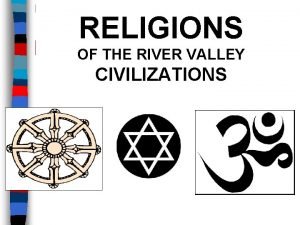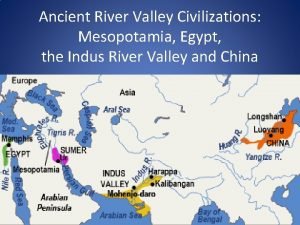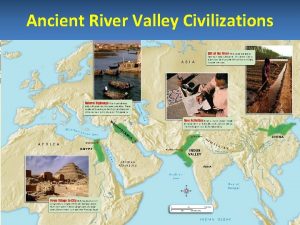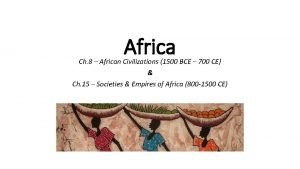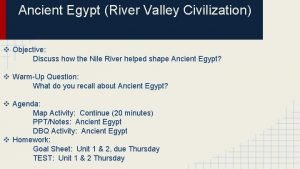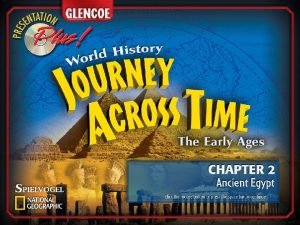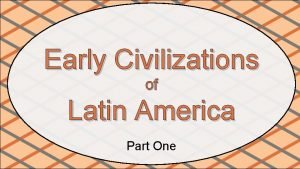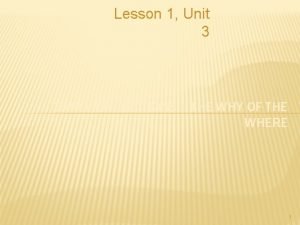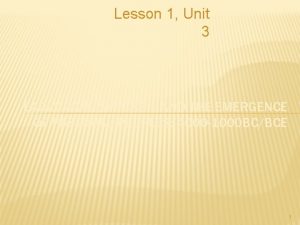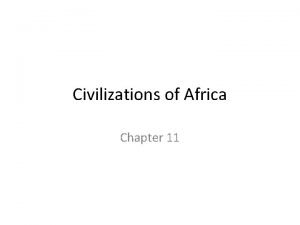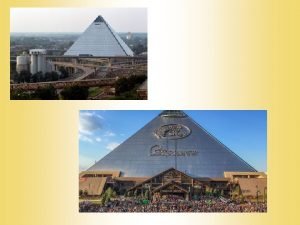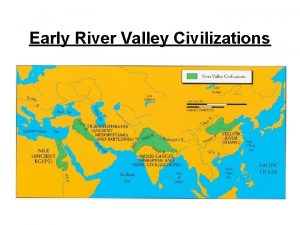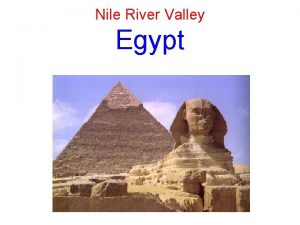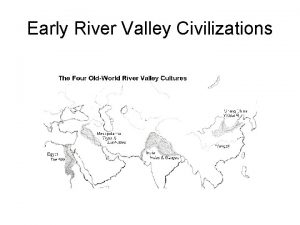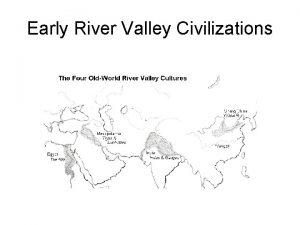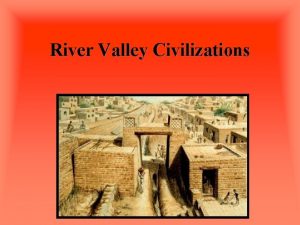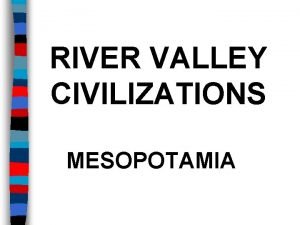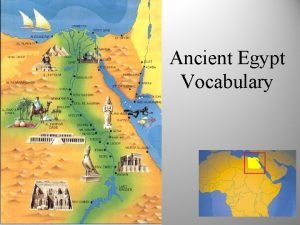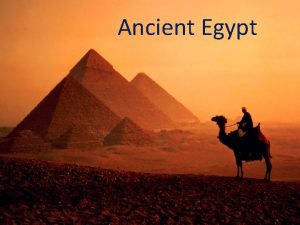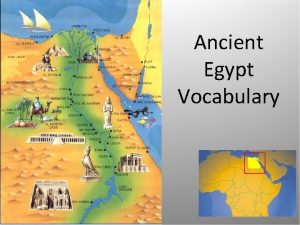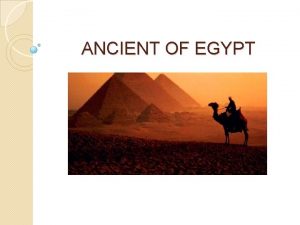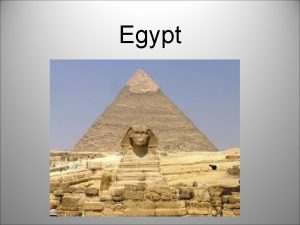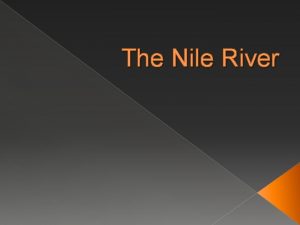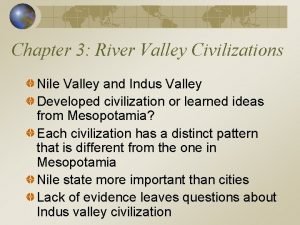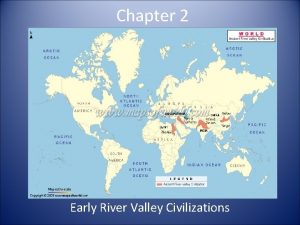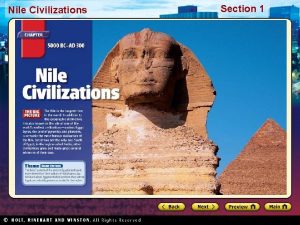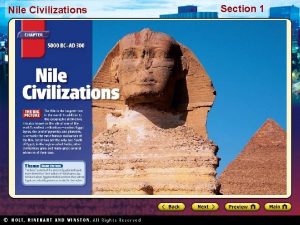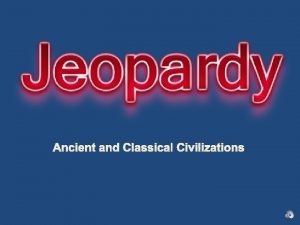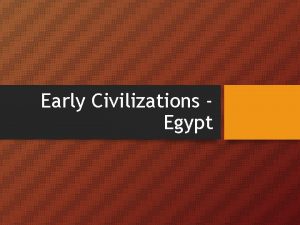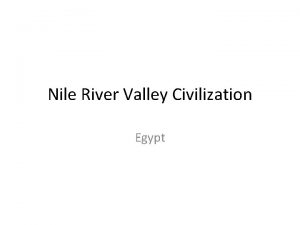Early River Valley Civilizations Egypt Nile River Longest




























- Slides: 28

Early River Valley Civilizations: Egypt

Nile River: Longest river in the world (4, 100 Miles) Farm the land prepared it for wheat and barley (thanks to silt). Used irrigation

Nile River

Effects of the Nile Too little Flooding=starvation Too much Flooding=destruction Egypt=Isolated

Upper and Lower Egypt Upper Egypt: South; Higher elevation than Lower Egypt: to the North, near the Nile River Delta (a triangular area formed by silt at the mouth of the river). Nile flowed (South to North), Winds Blew (North to South): This travel promoted trade and cultural unity.

Upper and Lower Egypt

Unification of Egypt Upper Egypt and Lower Egypt had their own kingdom. 3000 BC: Narmer unified the two kingdoms. First Egyptian Dynasty Old Kingdom: 2660 to 2180 BC (cultural patterns became widespread).

Narmer

Unification of Egypt

Pharaohs Pharaoh: Egyptian god-king Treated like a god Politics and religion Theocracy: government ruled by religious officials

Pharoah

Pyramids Tombs for the pharaohs of the Old Kingdom. Ka: the spirit of a dead pharaoh was said to have needs=the pyramids were built Pyramids would include riches, gold, pets, etc. for the pharaoh to have in the afterlife. Built by peasants. Shows the power of Egyptian society, technology, economy, and leadership.

Pyramids

Sphinx

Sphinx

Religion Polytheistic Worshipped over 2, 000 gods Ra: Sun god Osiris: god of the dead Isis: goddess of the ideal wife and mother.

Egyptian Gods Horus: sky; pharoah Set: Chaos Thoth: Knowledge and Writing Khnum: Creator Hathor: Love and Joy Sobek: God of the Nile Ra: Sun

Egyptian Gods Amon: King of the gods Ptah: Craftsmen Anubis: Death Osiris: Death/Underworld Isis: Protection, Women

Religion Afterlife Positive outlook; life continued after death (the Other World). Elite Egyptians=mummified. Mummification: embalming and drying the body=preservation=soul could return later. Book of the Dead: scrolls of hymns, spells, and prayers which would be used by the person in the afterlife.

Mummy

Sarcophagus

Egyptian Society �Social Hierarchy: King/Queen/Royal Family Other Elites (wealthy landowners, military officials, priests, etc. Middle Class (merchants and artisans) Peasants Slaves (later on in Egyptian history; prisoners of war; worked as servants or in gold mines). �Hierarchy was not permanent; people could work hard and make it to other levels of society with literacy �Slaves could even earn their freedom. �Women had a high status in society.

Writing Hieroglyphics: a form of writing in which pictures and/or symbols represent sounds. Earlier Sumerian pictographs (pictures stood for ideas).

Hieroglyphs

Innovations Mathematics: for taxes. Developed a near-accurate calendar of 365 days (12 months with 30 days each, and 5 extra days for holidays and festivals). Engineering helped build things Used medicine and surgery.

Changes in Egypt Old Kingdom declined in 2180 BC Powerful pharaohs regained control during the Middle Kingdom (2040– 1640 BC) Restored law and order Hyksos: a group of people who invaded Egypt. Ruled from 1630 to 1523 BC. After this, however, the New Kingdom would rise.

Cartouche On the front, write your first and last name in Egyptian Hieroglyphs. Color the entire project. Answer questions on the back in full sentences!!!

Is it difficult to write your name in hieroglyphs as opposed to letters? Explain. Why do you think that the Egyptians were so obsessed with the afterlife? Should their religion and society have been connected or separate? Explain. As a prediction, what role do you think that religion will play throughout world history?
 River valley civilizations def
River valley civilizations def Chapter 2 early river valley civilizations
Chapter 2 early river valley civilizations Egypt advanced cities
Egypt advanced cities Indus river valley job specialization
Indus river valley job specialization River valley civilizations map
River valley civilizations map Seasonal winds that dominate india's climate
Seasonal winds that dominate india's climate Yellow river civilization map
Yellow river civilization map Longest river in the world
Longest river in the world River valley civilizations definition
River valley civilizations definition River valley civilizations map
River valley civilizations map Ancient river valleys map
Ancient river valleys map River valley civilizations religion
River valley civilizations religion River valley civilizations vocabulary
River valley civilizations vocabulary 4 river valley civilizations
4 river valley civilizations Civilization ppt template
Civilization ppt template Aksum had access to the red sea blue nile and white nile
Aksum had access to the red sea blue nile and white nile How did the nile shape ancient egypt dbq answer key
How did the nile shape ancient egypt dbq answer key Egypt is the gift of the nile
Egypt is the gift of the nile How did the nile shape ancient egypt
How did the nile shape ancient egypt Janapriya nile valley
Janapriya nile valley Guided reading activity 2-1 the nile valley answer key
Guided reading activity 2-1 the nile valley answer key Inca diorama
Inca diorama Lesson 1 early civilizations
Lesson 1 early civilizations Ancient india lesson 1 early civilizations
Ancient india lesson 1 early civilizations Unit 3 lesson 1 sumer and mesopotamia
Unit 3 lesson 1 sumer and mesopotamia Chapter 11 section 1 early civilizations of africa
Chapter 11 section 1 early civilizations of africa Cahokia apush definition
Cahokia apush definition Upper egypt and lower egypt
Upper egypt and lower egypt Nile river basin
Nile river basin
